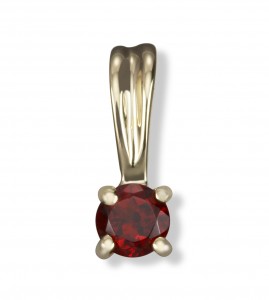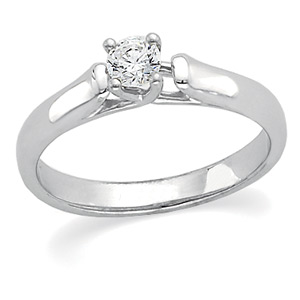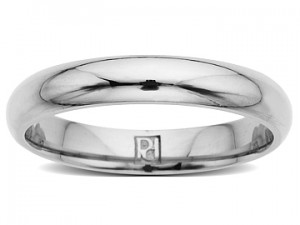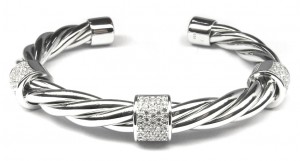
Have you ever wondered about the difference between White Gold and Silver? Or wanted to learn more about Platinum and Palladium? Do you know what makes for a “precious metal” and how they are used in fine jewelry? Read on to find answers to these and many other questions on the typical metals used in fine jewelry.
Gold, Platinum, Palladium and Silver are all classified as “precious” metals. “Precious metals” are metals that are usually found in their pure state in the earth. All of these metals can be cast, soldered and repaired by a jeweler should you need any repair work done. They are used in fine jewelry both for their rarity as well as for their structural integrity. However, within the group of precious metals, each metal has its own pros/cons and ‘look’. In this article, we explore the basic differences of the most common precious metals used in jewelry and some of their unique traits (or click here if you want to learn about some alternatives to precious metals).
What type of Gold is best for Jewelry?
Gold, as it is found in nature, is yellow in color and is mined in a variety of ways. Gold is described as ‘24k’ when in its purest form and before it has been alloyed or ‘mixed’ with another metal. 24k gold is so soft that it is rarely used in jewelry at that level of purity. Gold is often alloyed with other metals and minerals to obtain the desired karat of the finished piece. This alloying not only changes the color of the metal slightly, but also hardens the gold so that it can be used easily when fabricating jewelry.
- In jewelry, Gold has a karat marking to signify the karat gold used in the piece. The most common markings are 10k, 14k, 18k, 20k and 22k. Alternately, you might instead also see the numbers ‘585’ or ‘750’ to indicate 14k or 18k gold respectively. These number refer to the “parts per thousand” of gold found in that alloy
- 18k yellow gold (18 parts gold per 24 parts) has more gold in it than 14k (14parts gold to the 24parts total), and will thus appear more “yellow”.
- By law, 10k is the lowest karat allowable for sale in the United States. Should you find estate pieces marked 9k, these likely came from Great Britain.
- Gold can be alloyed to produce a rainbow of colors. Common colors of gold are white gold, rose gold (sometimes called “red gold”), green gold, purple gold and many more.
What is White Gold?

Outside of the traditional ‘yellow’ gold, White Gold is the most commonly alloyed version found in the jewelry industry. White Gold is made by alloying Gold (yellow in its natural form) with another ‘white’ metal to achieve the desired color. Because Gold is yellow in its natural state and is alloyed to appear ‘white’, often when finishing a piece made of White Gold, the final step is to apply Rhodium plating (a type of platinum). This brightens the metal and makes it appear a ‘white white’. This coating is a form of electroplating and creates a microscopic shell over the gold. Over time and through normal use, this rhodium plating will wear off. In the case of jewelry, it will need to be fully polished and cleaned before the plating can be applied again. Without the Rhodium plating, a white gold ring will have a slight yellow cast to it (again, being made from gold, this is simply its nature!).
Is Platinum good for jewelry?

Platinum is a noble metal (i.e. metals that are resistant to corrosion and oxidation) and is denser, and thus heavier, than gold. Identically sized objects made of gold and platinum will result in the platinum object will have more weight. This density is a benefit for jewelry, as it gives the piece longevity. Platinum is usually used in a nearly pure state, often only having 5% to 10% alloys in comparison to gold’s 25% to 50% alloying.
- Platinum is a purely white metal in its natural state. No plating or finish needs to be applied. Because of the density of platinum, it tends to wear a little ‘softer’ so a scratch will be rounded at the surface. By contrast, a scratch in gold is much sharper and shiny; it will appear as more of a ‘cut’.
- For a jeweler, Platinum is more expensive to work with gold (so you need to know this when deciding between white gold and platinum). Casting and polishing materials for platinum cost more and this will usually be reflected in the cost of platinum pieces.
- The majority of platinum on the market will be marked with “Pt” or “Plat” and either “900” or “950” to indicate the parts per thousand that are platinum versus the alloy.
Is Palladium good for Jewelry?

Another white metal option is Palladium, which is a hybrid between Platinum and White Gold. It is often grouped with Platinum, but of all the metals in the Platinum group, it has the lowest density and the lowest melting point…thus giving it properties more similar to those of white gold.
- Palladium was used in jewelry en masse around the start of World War II because Platinum was declared critical resource for the war effort. Palladium offered the desired “true white” color of Platinum, with malleability similar to White Gold.
- However, there are some cons to palladium, namely its tendency to become brittle. Thus, today it is often recommended for plain bands than for jewelry that have prongs or required to hold gemstones.
- Similar to the markings for platinum, palladium is marked by “Pd” or “Pall” and either “900” or “950” depending on the amount of alloy that is present.
Is Sterling Silver good for jewelry?

Silver is often used in estate pieces as well as contemporary jewelry today because of its relative low cost in comparison to gold and platinum.
- You will find the marking “925” which indicates that it is sterling silver.
- It should be noted that silver is significantly softer than the other metals listed and is not recommended for fine jewelry items that will be set with gemstones or have engraving.
These metals used often in the fine jewelry industry, are diverse and offer many different properties and jewelry looks. From soft and delicate details to sharp and precise lines, these metals can be used to fabricate just about any jewelry piece that you can imagine! Gold, Platinum, Palladium and Silver have been used for centuries and will continue to be used for centuries more in fine jewelry. Do you have a preferred metal for your jewelry?
